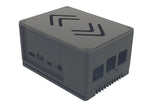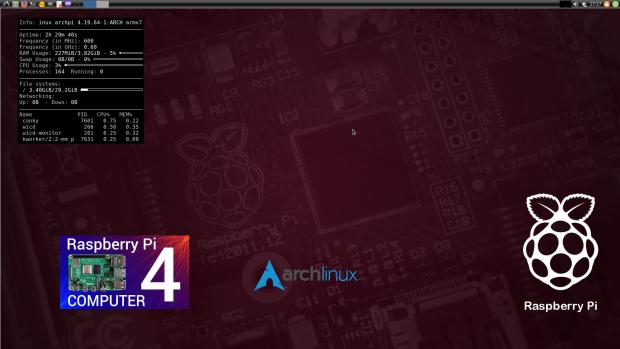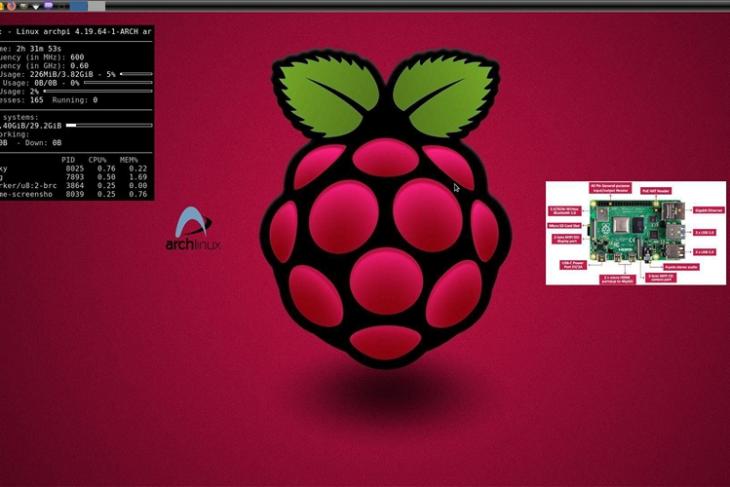-
Hey Dirk, so what is your SBC of choice today?
-
My SBC of choice today would be the Odroid-N2+, as it runs pretty cool (with the fan that serves as standoff it stays below 40 Celcius here) and runs on both 64-bit Linux and 64-bit Android.
It has six cores, of which four are Cortex-A73's @2400MHz and those are at the moment the best CPUs in SBC land. The other cores are Cortex-A53's @2016MHz.
The only thing lacking with the Odroid-N2+ is the amount of RAM. Do NOT buy the 2GB variant, even the 4GB variant should be upgraded in my eyes to at least 6GB and preferably 12 GB.
I have yet to break in my Compute Module but though I am convinced it will be my strongest Raspberry board I do not think it will surpass the Odroid-N2+, even though it has a whopping 8GB of RAM for its four cores.
For 32-bit work the Odroid-XU4 performs as well as a Raspberry Pi 4, thanks to its eight cores (four Cortex-A15 and four Cortex-A7). The possible 32-bit Android work for the XU4 seems to have all but dried up.
Most BOINC projects seem to have your smartphone with its eight-core 64-bit SOC in their minds when developing Android applications. The 2GB of RAM in the XU4 for its eight 32-bit cores is a bit meagre here.
Also 32-bit-wise, the ASUS Tinker Board performs very nice but has but four Cortex-A17 cores. The 2GB of RAM for the four 32-bit cores is good.
As soon as CUDA and/or OpenCL Android and/or Linux/ARM applications become available with BOINC, the nVidia Xavier boards could become interesting too.
Last edited by Dirk Broer; 10-10-2021 at 11:49 AM.
-
The guys at Raspberry.org have released an official 64-bit Bullseye version of their Debian-based OS.
This gave me the chance to upgrade a Raspberry Pi 3 to use a 64-bit OS, but I have yet to see the advantage of it. It looks like the 1GB of relatively slow RAM is a bottleneck.
Update: It looks like Bullseye needs more power than previous versions, as I was getting too low voltage warnings (got them on my original Pi B+ too).
I went for more expensive USB-cables and found 64-bit Bullseye scoring double the Integer and floating point marks:
1434 floating point MIPS (Whetstone) per CPU
32685 integer MIPS (Dhrystone) per CPU
...and not only were the benchmarks doubled, the computation times for WEP-M+2 were halved too -and that's where it counts!
Last edited by Dirk Broer; 03-25-2022 at 12:57 AM.
-
After the successful transformation of the two Raspberry Pi 3's from the 32-bit into the 64-bit part of the fleet there is a new success to be reported: the Admiralty has been able to secure a Radxa Rock Pi 4B+ with 32 GB eMMc for the 64-bit fleet, plus a Xigmatek Porter N881 for the 32-bit fleet -already the third super-cooler since the Admiralty went for that. There is also talk about procuring a Radxa CM3 plus IO board combo in China, along with a big heatsink for the Rock Pi 4B+ (v1.6 with the faster OP1 edition of RK3399).
The only setback that the Armada presently faces is that the two Cubieboard 4's still won't play along nicely with the rest of the fleet. We either get them going on way too weak PSUs which makes them fail as soon as BOINC starts, or they won't even boot when connected to an able PSU.
-
Yet another day in SBC-City, home of the ARM fleet (a.k.a. ARMada)
The SBC-City housing committee has voiced its concerns at the fleet about temperatures in Raspberry Towers no. 2B. Though the inhabitants of nearby no. 3B are doing quite well after their changeover to a 64-bit OS, the inhabitants of 2B are very much bound to a 32-bit OS due to their ARM Cortex-A7s and, from the low voltage warnings on the screen, it looks like they are really having trouble running both CPU and 30mm fan at 5 Volt. This never was the case when an external duo of 120mm fans still kept the ARM fleet cool. The idea is now to mod the PiHut housings of both 2B and 3B by taking the mid-level out, so room comes available for 52Pi Ice Tower Low profile coolers. The two 2B inhabitants so will use up almost all PiHut space, and at least one of the inhabitants of 3B will therefore be housed in the remnants of old Raspberry Towers -presently in use by the Odroid-C1. The idea is that the predicted lower temperatures will increase performance for all four Raspberries.
At last fleet manoeuvres it was established that the Raspberry Pi 2B performs roughly 10 times as fast as the Fleet's original Raspberry Pi Model B+, and five times as fast as the famous Beaglebone Black under the same underlying Debian version. The 3Bs that originally were almost twice as fast as the 2Bs (and performed at the level of the 1500 MHz Cortex-A5 Odroid-C1) are now trice as fast due to their 64-bit OS and perform even better than the ASUS Tinkerboard with its high-end 32-bit Cortex-A17. With the 52Pi Ice Tower Coolers fitted they might be able to do an overclock to at least 3B+ level, meaning 1400 instead of 1200 Mhz. 1500 might even be reached...
The 1400+ MHz would bring them at the same level, Hertz-wise, as the previous low-end 64-bit crunchers: the Nvidia Jetson Nanos, with their Cortex-A57 Tegra SOCs. Their superior IPC, as compared to the Cortex-A53, makes that they perform twice as fast though -at least on the WEP-M+2 Project. This makes fleet procurement look into the rumoured king-of-performance-per-Watt: the ARM Cortex-A55, meaning the Odroids C4 and M1, the Radxa Rock 3A/3B and the Banana Pi M5. At the present SBC supply shortages not all of these can be bought at any time soon though, and Fleet procurement would actually rather have any model of the Raspberry Pi 4 than a Cortex-A55 board, and when pushed to the choice preferably an Odroid-N2+. The Fleet's experimental branch however, that is soon forced to finally hand over the Raspberry Pi CM4 and the Radxa Rock Pi 4B to the operational part of the Fleet, now wants an Odroid-M1, pointing at the availability, the relatively low price (at least for the 4GB model), the much better M.2 NVMe storage option, the higher DDR4 speed and the included NPU.
Last edited by Dirk Broer; 05-20-2022 at 12:15 AM.
-
Today the Raspberry Pi CM4 was handed to the active fleet by the Fleet's experimental branch, but grudgingly. The experimental department is not happy with the speed -stock @1500 MHz- and the chosen cooling solution, a 140mm Noctua Redux
raspberry-pi-cm4-noctua-fan-overclock-test-setup-image.jpg -a la Jeff Geerling-
blowing over the CPU, but in this case helped by a Xigmatek Porter N881 chipset cooler on top of the CPU. But just not fastened as the experimental department would have had it.
There are plans to mount a Noctua NC-U6 or a PCCooler HB-802, but the experimental department is still looking for a way to securely fasten the cooler to the module/IO board combo. Soon as that happens, 2300 MHz is the very least the Fleet hopes for.
Next launch will be the Rock Pi 4B, in its metal passive cooling case:

The experimental branch is planning an old Pentium Pro cooler as footing, aided by a 40mm Noctua @5V blowing through it. On top they are thinking of a 80mm Noctua @3.3V, to suck hot air out.
All this will mean the end of active service for the old LeMaker Banana Pro, and now the Raspberry Pi 2s and the Banana Pi M2 come in the danger zone. The Raspberries get a chance with Ice Tower coolers to crank up their daily score and their maximum MHz limit, but the Banana Pi M2 already has an even better cooler and has to try to get overclocked to somewhere in the 1200 MHz.
Last edited by Dirk Broer; 05-26-2022 at 10:13 PM.
-
The experimental department got its Odroid-M1 today, it is now waiting for an M.2 NVMe drive to install an OS, straight from the 'petitboot':
"Petitboot pre-installed into the on-board 16MiB of SPI-Flash Memory helps manage various OS and kernel versions easily and supports booting from microSD, eMMC, NVMe, SATA, and USB storage devices".
Also arrived: two low profile 52Pi ice tower coolers, that went to the completely re-vamped '2B, Raspberry Towers' estate, and two 5V 80mm Noctua's, to help cooling the Odroid-XU4 (in combination with the Xigmatek N881) and the Rock Pi 4B. The chief engineer insists on a 80 to 60mm fan adapter, to make sure the fan fits properly into/unto the Radxa housing. He's a very suspicious man, our chief engineer! He doesn't quite trust the passive cooling housing, as he fears heat will be trapped on the inside. And he isn't all too keen on heatsinks that stand on the ground either.... and then to think of it that his engineering degree is actually in software....
As the Xigmatek N881 is in use at the very moment for the compute module 4, a new dedicated CM4 cooler has been ordered, combining heatsink and fan. The chief engineer seems to secretly hope to be able to mod a Cooler Master Evo 212 or 412S unto it.
The planning is that all new systems are in full operation before valterc of BOINC.Italy overtakes me at the WEP-M+2 Project.
Last edited by Dirk Broer; 10-18-2022 at 03:03 PM.
-
I like how the Experimental Department seem so demanding. Good on them.
They might like to consider running newer kernels than come with RaPi Debian
Maybe a RaPi Arch could show an edge.
I like Manjaro these days as it back-grounds the Arch install steps and still leaves me with the Arch functionality.
Some Manjaro ARM installs are a bit slow to boot, but there was some slowness with recent kernels so not all Manjaro's blame.
Linux kernel 5.18 has numerous fixes and boots like a champ.
But for a bare-bones install I'd go raw Arch with judicious low-level compile options and leverage every ounce of chip feature that you can.
It's just fast. And then you make it faster. With nothing else there unless you put it there.
Just some thoughts for the Experimental Department
. . . . . ___
. . . . . . .\___/\ ______
______
. . . . . . .  \__AMD___\
\__AMD___\ \__
---------------------------------------------
\__
---------------------------------------------
-
Arch holds an advantage over Manjaro for my ARMada, as ArchLinux|ARM still supports 32-bit boards as the BeagleBone Black, the Odroid-C1, the i.MX6 Cubox/Hummingboard and the Raspberry Pi 2.
Manjaro seems to have gone 64-bit only.
For the Raspberry Pi's there is yet another option to run Arch: RaspArch


32-bit RaspArch Build 220216 comes with kernel 5.15.21-3-rpi-ARCH. After the Commands: followed by that kernel should be replaced with 5.18, hopefully.
Note: My Raspberry CM4 Compute Module -that has been imaged as last- runs 64-bit Raspberry Pi OS with kernel 5.15.32. Running a 64-bit OS halves the computing time as compared to a 32-bit OS when running WEP-M+2 (wanless2) - tested this via my Raspberry Pi 3's.
Last edited by Dirk Broer; 06-22-2022 at 08:25 AM.
-
Good then that my son loaded my ARMs with Arch!
 Posting Permissions
Posting Permissions
- You may not post new threads
- You may not post replies
- You may not post attachments
- You may not edit your posts
-
Forum Rules
______
\__AMD___\
\__